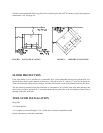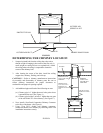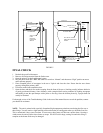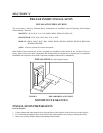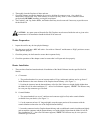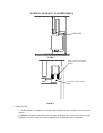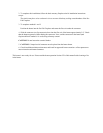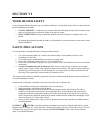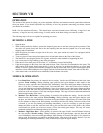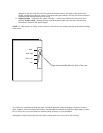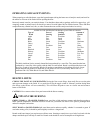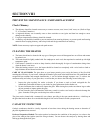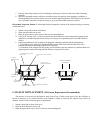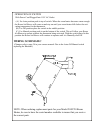
SECTION VI
WOOD HEATER SAFETY
Certain safety hazards are inherent in any wood heater installation. You should be aware of these so that a safe and
proper installation can be made.
1. FAULTY CHIMNEY: An older masonry chimney should be thoroughly checked to be sure there are no
holes or weak spots which could allow sparks or hot gases to escape.
2. HEAT CONDUCTION: Placing combustible materials too close to a heater or chimney can be a fire
hazard.
By keeping these particular hazards in mind as you install and use your room heater you can ensure a safe,
reliable installation.
SAFETY PRECAUTIONS
For your protection, read and follow these safety precautions closely.
1. Use a spark arresting shield (3/8” mesh) on top of the chimney. Check monthly as this is a code
requirement in some areas.
2. Use smoke detectors around the heater as well as in sleeping areas.
3. Keep a fire extinguisher rated for Class “A” fires near the heater.
4. Check with your insurance company to be sure your policy covers the installation and use of a wood fired
room heater.
5. Creosote-Formation and Need for Removal: When wood is burned slowly, it produces tar and other
organic vapors, which combine with expelled moisture to form creosote. The creosote vapors condense in
the relatively cool chimney flue of a slow-burning fire. As a result, creosote residue accumulates on the
flue lining. When ignited this creosote makes an extremely hot fire.
The connector and/or chimney should be inspected at least once a month during the heating season to determine if
a creosote buildup has occurred.
If creosote has accumulated, it should be removed to reduce the risk of a chimney fire.
6. Locate furniture and any other combustibles away from the heater.
7. Store firewood at a safe distance from the heater.
8. Disposal of Ashes: Ashes should be placed in a metal container with a tight fitting lid. The closed
container of ashes should be placed on a non-combustible floor or on the ground, well away from all
combustible materials, pending final disposal. If the ashes are disposed of by burial in soil or otherwise
locally dispersed, they should be retained in the closed container until all cinders have thoroughly cooled.
Ashes can ignite up to 72 hours after removal.
9. Always exercise caution when using your heater. Be particularly careful when there are children around
an operating heater.
CAUTION!!
NEVER use gasoline, gasoline-type lantern fuel, kerosene, charcoal lighter fluid or similar
liquids to start or “freshen up” a fire in the heater. Keep all such liquids well away from the stove when it is in use.
All fluids of this type give off volatile fumes and can and WILL EXPLODE!! Don’t take a chance with the
safety of your home and family.



